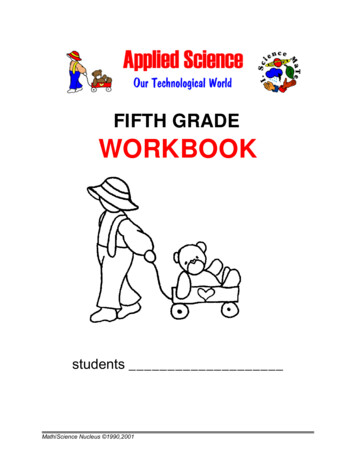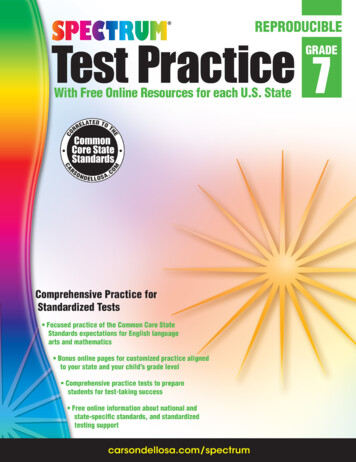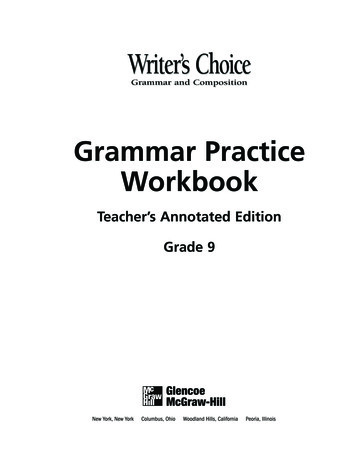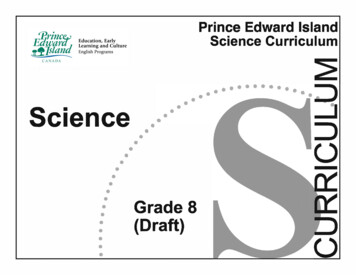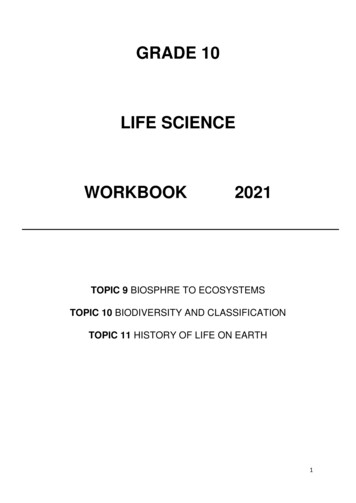
Transcription
GRADE 10LIFE SCIENCEWORKBOOK2021TOPIC 9 BIOSPHRE TO ECOSYSTEMSTOPIC 10 BIODIVERSITY AND CLASSIFICATIONTOPIC 11 HISTORY OF LIFE ON EARTH1
WELCOME GRADE 10’sThis workbook has been created for the student, to be used as primary learning aidfor the Life Sciences Grade 10 curriculum.It covers all necessary content, and includes exercises and activities to test yourknowledge on the content covered.Memorandums for exercises and activities will only be provided when proof can begiven that the exercise/activity has been completed by the student.The student will receive a calendar that should be used in conjunction with theworkbook as a guideline for work to be completed each day. Please write the datenext to each day’s work in the space provided.Please make sure that workbooks and textbooks are covered accordingly.The formal assessments for 2021 will be as follow:I look forward to working with you this year. If we put in the necessary effort and staymotivated, 2021 will be a success.Kind regards,Mrs. T.A FarmerLife Sciences Grade 102
Topic 9BIOSPHERE TO ECOSYSTEMSContent Biosphere: Concept of the biosphere. Interconnectedness with and components ofglobal ecosystems: hydrosphere, lithosphere, atmosphere. Biomes: Terrestrial and aquatic biomes of Southern Africa: how climate, soils andvegetation influence the organisms found in each. Location of different biomes inSouth Africa. Environment: Concept of environment to show human activities in and interactionswith the natural environment Abiotic and biotic factors and their effect on thecommunity. Ecosystems: Concept of ecosystem. Structure and ecosystem functioning. Energy flow: Energy flow through ecosystems and the relationship to trophicstructure. Trophic levels. Cycles: Flow charts of, CARBON, NITROGEN, WATER, OXYGEN.Day 1Date: The BIOSPHERE is the global sum of all ecosystems. It is that part of the earth's surface where life is possible. The different components of the biosphere are the lithosphere, hydrosphere andatmosphere. The biosphere is divided into an abiotic, or non-living component and a biotic, orliving component. A constant interaction between the biotic and abiotic components in the lithosphere,hydrosphere and atmosphere is responsible for the exchange and conversion of food,energy and other essential substances to make life on earth possible.3
The Earth's LITHOSPHERE consists of the earth's crust including the upper solidmantle just below the crust. The lithosphere (continental crust) is the home of land animals and plants as well asvarious microorganisms. The HYDROSPHERE is the liquid water component of the Earth. It includes oceans,lakes, dams, rivers, streams as well as groundwater and cover about 70% of theEarth's surface. Many plants, animals and microorganisms live in the hydrosphere. The water in the hydrosphere continuously circulates to form the water cycle. The ATMOSPHERE is the layer of gases surrounding the earth and is held in placeby the earth's gravitation. The Earth's atmosphere consists mainly of nitrogen, but also contains oxygen which isused by most organisms for respiration as well as carbon dioxide which is used byplants, algae and blue-green bacteria for photosynthesis. The atmosphere also protects organisms against genetic damage through theultraviolet rays of the sun.4
The concepts ENVIRONMENT and ECOLOGY are often used as synonyms,although there is a distinction between these two terms. The environment is the total sum of all living organisms, including the natural, nonliving factors (abiotic factors) as well as all living organisms (biotic factors) thatcontribute to growth and development, but also cause harm and/or danger. Ecology is the study of interactions and processes that exist between organisms andbetween organisms and the environment.Test yourself:Complete ACTIVITY 1 on page 198 in your Life Science, Via Afrika textbook.Complete ACTIVITY 2 on page 199 in your Life Science, Via Afrika textbook.(Scientific skills)Day 2 and 3 Date:The ABIOTIC COMPONENT is the non-living chemical and physical factors of theenvironment. Abiotic factors are very important and greatly affect the biotic factors.5
We will discuss the following abiotic factors of the environment:- Physiographic factors-SlopeRefers to how steep, or how flat an area is.Steep slope: Fast water run-off, leads to soil erosion.-AspectThe direction that the area faces.North-facing slopes will receive more direct sunlightSouth-facing slopes will receive more shade.-AltitudeThe height of the land above sea level.Higher altitudes the wind speed is greater, temperature lower and rainfall higher.Lower altitudes the wind speed is slower, temperature higher and rainfall lower.- Edaphic (soil) factors-pH levelAcidic soil has a pH of less than 7.Alkaline soil has a pH of greater than 7.-Hummus contentMore hummus will increase the fertility of the soil.-Soil textureSandy soil: Soil particles are large, low water retention.Loam soil: Mixture of sand and clay.Clay soil: Soil particles are waterlogged, high water retention.Soil airSpaces found between the soil particles.- Physical factors-SunlightPhotoperiodism: Organisms response to the length of day and night.-TemperatureSome organisms hibernate in winter (colder temperatures)Some organisms aestivate in summer (warmer temperatures)-WaterHydrophytes are adapted to live in water. (Summarise P.216)6
Reptiles are adapted to conserve water. (Summarise P 217)-WindTest yourself:Complete EXERCISE 3 on page 218 in your Life Science, Via Afrika textbook.Day 4 Date:The BIOTIC COMPONENT of an ecosystem is the biodiversity of the ecosystemand consists of a large variety of living organisms including plants, animals, fungi,algae, protozoa and bacteria. Each of these organisms interacts with the abiotic environment as well as the otherliving organisms in their specific ecosystem. Humans also form part of the bioticcomponent. In terms of nutrition, each organism has a specific position within the ecosystem:- Green plants are the primary producers who produce food through the process ofphotosynthesis. Green plants produce their own organic food and are thereforeautotrophic.- Autotrophs are divided into: Hydrophytes – plants that grow in water Mesophytes – plants that need moderate supply of water and food Xerophytes– plants that grow in very dry conditions- Organisms that cannot produce their own food are heterotrophic.- Heterotrophs are divided into: Herbivores – consume plants Carnivores – consume meat Omnivores – consume both meat and plant material Saprophytes (Decomposers) – plants that live on dead organic matter Parasites – plants or animals feeding on other living organismsTest yourself:Complete EXERCISE 2 on page 212 in your Life Science, Via Afrika textbook.7
Day 5, 6 and 7 Date:Biomes are large areas with a specific climate. The area contains specific kinds ofplants and animals.Table indicating the different Marine Biomes of South-AfricaThe ocean tides, currents, temperature changes and how much oxygen and salt is in the waterall have an effect on the kinds of animal and plant communities found along the coastline.BiomeFeaturesSandy beaches-Moving layer ofContinual-Plough snail-Pollutionsandchanges to-White mussel-Beach vehicles-Ocean meetsenvironment-Ghost crab-Humanland (Intertidalprevent plantszone)from growing.-Habitat of great-Different-Mussels-Pollutiondiversityspecies of-Oystersbrought by-Along coastlineseaweedsRocky shoresPlantsAnimalsThreatsdevelopmentrivers (Sewage)-Humaninteraction.Coral reefs-Marine-Large diversity-Largest-Collectingorganism thatof plant species.diversity ofcoralgrows inmarine animal-Overfishingcolourfullife.-Globalclumps.Open sea-No firm basewarming-Algae-Diversity of fishPhytoplankton-Pollution fromships-OverfishingEstuaries-Meeting place-Organisms-Organisms-Leaching andof rivers and themust bemust beeutrophicationsea.speciallyspeciallyinto rivers can-Freshwateradapted to liveadapted to livecause harm tomeets saltwaterherehereestuaries.-Diversity of-Diversity of8
different plantsdifferentgrow here.animals livehere.Table indicating the different Terrestrial Biomes of ts-Mixed-Baobab,-Wild animals-Huntinggrasslands andMopani and-Livestock that-Unfriendlytrees.Acacia trees.graze grasses.tourism.-Grass as main-Diversity of-Diversity of-Commercialvegetationdifferent grassantelope.forestry and-24% of Southspecies.-Variety offarming.-46% of SouthAfrica.-Summerrainfall with hottemperatures.GrasslandAfrica.birds.-High rainfallandthunderstormsin summer andfrost in winter.Nama Karoo-Warm/dry-Sweet thorn-Variety ofsemi-desert-Stone plantrodentsclimate.-Karoo daisy-Ostrich-Sandy soil with-Overgrazing-Reptileslittle nutrition.SucculentKaroo-Winter rainfall-Succulent-Dassie ratwith veryplants with thick-Barking gecko.hot/dryfleshy leaves.summers.-Annual plants-Overgrazing9
-Sandy soil withlittle nutrition.Fynbos-Western ountain zebra-Uncontrolled-Declared world-Diversity of-Leopardfires.heritage site.shrubs.-Alien plants-Cold wet-8570 species of-Globalwinters, hot dryflowering plants,warming.summers.fynbos is one ofthe most diversefloras in theworld.Forest-High rainfall-Diversity of-Blue duiker-Deforestation-Very small parttrees-Knysna loerie-Developmentof South African-Ferns and vinesbiomesThicket-Sandy and clay-Diversity elopment-Found in riverevergreen forestvalleysand succulents.Table indicating the different Freshwater Biomes of South-AfricaFreshwater refers to rivers, streams, ponds, lakes and wetlands. Climate change affects ats-Soil is-Plants that-Wildlife-Pollution due towaterloggedprovide food-Wetland cranedumping large-Aids in floodand shelter foramounts ofcontrolmany animals.waste.-Improves waterquality bytrapping10
dangeroussedimentsTest yourself:Complete EXERCISE 1 on page 207 in your Life Science, Via Afrika textbook.Day 8 and 9Date:Why do we eat?We eat to get energy for all the different processes to keep us alive. (And also to get a sourceof carbon and other organic molecules that build our bodies.)All organisms need energy for growth, movement and reproduction. The energy inecosystems comes from the sun and flows in one direction only: to producers, to consumers,to decomposers.Producers change the sun’s energy into chemical energy through photosynthesis.Primary consumers (herbivores) consume the producers.Secondary consumers (carnivore/omnivore) consume primary consumers.Decomposers (fungi and bacteria) get their energy from the bodies and waste of deadproducers and consumers.Food chains: Show the energy flow from one organism to the next. Set out as a flowdiagram. Each level of the food chain is called a trophic level.(Draw your own P 219)Food web: Made of several interlocking food chains.(Draw your own P 220)11
Test yourself:Complete CASE STUDY 1 on page 220 in your Life Science, Via Afrika textbook.Day 10 and 11Date:Food pyramid: Pyramidal shapes that show how much is eaten at each trophic level. Pyramid of energyAt each trophic level about 90% of the energy is lost as heat. The total energy passedfrom one level to the next is about 10%. This indicates that the amount of energydecreases towards the tip of the pyramid.This means that the total amount of energy stored in the bodies of a given populationdepends on its trophic level.(Draw your own P221) Pyramid of biomassA count of the population, multiplied by the weight of an average individual in it, givesan estimate weight of the population. The total mass of living organisms at one trophiclevel.(Draw your own P222)Test yourself:Complete ACTIVITY 4 and EXERCISE 4 on page 222 and 223 in your Life Science,Via Afrika textbook.12
Day 12, 13 and 14Date:NUTRIENT CYCLES Water cycleImage also available in Life Science, Via Afrika textbook, Page 224(Summarise in words P 223)13
Carbon cycleImage also available in Life Science, Via Afrika textbook, Page 225(Summarise in words P 224)14
Nitrogen cycleImage also available in Life Science, Via Afrika textbook, Page 226(Summarise in words P 225) Oxygen cycleDraw your own oxygen cycle(Summarise in words P 226)Test yourself:Complete EXERCISE 5 on page 227 in your Life Science, Via Afrika textbook.Day 15 to 20: Revise Topic 9. Additional revision activities will be provided and classdiscussions and debates (if possible) will be held to lay down knowledge.Complete TOPIC QUESTION on page 239 in your Life Science, Via Afrika textbook.END TOPIC 915
Topic 10BIODIVERSITY AND CLASSIFICATIONContent Classification schemes: Brief history of classification Classification systems: Five-kingdom system; Animalia, Plantae, Fungi, Protista andMonera. Binominal naming system: History and applicationDay 21 and 22Date:BIODIVERSITYRead through pages 246-249 in Life Science, Via Afrika textbook and complete CASESTUDY 1 AND 2 on page 250 and 251 to test yourself.Day 23Date:CLASSIFICATIONClassification/Taxonomy is the sorting and grouping of organisms with similar features.Taxonomy has two branches:Nomenclature: Naming of organismsSystematics: Placing organisms into groupsHISTORY OF CLASSIFICATION-1758, Swedish botanist, Carolus Linnaeus, introduced a system to classify things.-Carolus Linnaeus is also the founder of binominal nomenclature.16
-The five kingdom system was developed by an American, Robert Whittaker, in1969:Kingdom: Monera (prokaryotic organsims such as bacteria)Kingdom: Protista (primitive eukaryotic organisms such as algae)Kingdom: Mycota (only fungi like mushrooms)Kingdom: Metaphyta or Plantae (advanced eukaryotic plants)Kingdom: Metazoa or Animlia (all multicellular animals)-1990 an Americam microbiologist Dr. Carl Woese developed a three domainsystem, with kingdoms in each:Eubacteria: Prokaryotic bacteriaArchaea: Bacteria that are prokaryotes and live under extreme conditions.Eukarya: Kingdoms Protista, Fungi, Plantae and AnimaliaDay 24Date:ORGANISMS CLASSIFIED PROKARYOTES AND EUKARYOTESProkaryotic cells are more primitive and existed before proper nuclei developedEukaryotic cells have a membrane bound nucleus.Images also available in Life Science, Via Afrika textbook, Page 25217
Test yourself:Complete EXERCISE 1 on page 253 in your Life Science, Via Afrika textbook.Day 25Date:FIVE KINGDOM CLASSIFICATIONSThe following characteristics about feeding are important when it comes to the five kingdomsystem:Autotrophic: Organisms that produce their own food through light energyHeterotrophic: Organisms that need to eat other organisms to gain energy.Saprotrophic: Organisms feed on dead plant and animal materialBINOMINAL NAMING-Latin namesScientific names are set in Latin language. The first part of the name is called thegeneric/genus name and the second part is the specific/species name.The genus name begins with a capital letter e.g. Homo.A species is a group of organisms that look alike, can interbreed and produce fertileoffspring. The species name is written with a small letter e.g. sapiens.(Biological names must be printed in italic or underlined if you are writing by hand: Homosapiens or Homo sapiens.)18
Day 26 and 27-Date:Classification keysClassification keys are used to name and identify unknown plants and animals. A key is a listof features that can be seen and compared to the unknown organisms. It can also be called adichotomous key.Complete EXERCISE 2 below as an example of how to use a dichotomous key.Test yourself:Complete EXERCISE 2 on page 256 and EXERCISE 4 on page 258 in your LifeScience, Via Afrika textbook.Day 28 to 31: Revise Topic 10. Additional revision activities will be provided and classdiscussions and debates (if possible) will be held to lay down knowledge.Complete TOPIC QUESTION on page 260 and 261 in your Life Science, Via Afrikatextbook.END TOPIC 1019
Topic 11HISTORY OF LIFE ON EARTHContent Geological timescale: Meaning and use of timescales (details not to be memorized). Cambrian explosion: Origins of early forms of all animal groups. Life-forms havegradually changed to become present life-forms. In the last four million yearssignificant changes have occurred in species occurring in Africa (e.g. humans) Mass extinctions: Causes of mass extinction. There have been five, two of which areparticularly important: 250mya (resulted in the extinction of about 90% of all life onEarth) and 65mya (resulted in the extinction of many species, including thedinosaurs). The rate of extinction on the Earth at present is higher than at any time inthe past. The present time has been called the sixth extinction. Fossil formation and methods of dating: Transitional fossils: Coelacanth,Archaeopteryx, Thrinaxodon. Both methods of fossil dating, radiometric dating andrelative dating.Day 32, 33, and 34Date:GEOLOGICAL TIMESCALEPalaeontologists have made a calendar of events in Earth’s history called the geologicaltimescale.This timescale shows how species evolved over time from ancestors that existed in the pastbut they look different because they change over long periods of time.All time is subdivided into units in descending order of era’s and periods.20
Test yourself:Complete ACTIVITY 1 on page 263 in your Life Science, Via Afrika textbook.21
Day 35 and 36Date:CAMBRIAN EXPLOSIONThe Cambrian period lasted for 38 million years. Compared to the age of the earth, all majorgroups of animals appeared on Earth in a very short period of time. In the first 5-20 millionyears all major groups of animals appeared known as: Platyhelminthes (flat worms),Nematoda (worms), Annelida (segmented worms), Mollusca (slugs, snails and creatures withshells), Arthropoda (invertebrates with external skeleton), Echinodermata (marineinvertebrates) and Chordata (vertebrates- with skeleton).From end Cambrian into Holocene, the fossil record shows that different groups of animalsevolved out of those primitive Cambrian forms:Fish: about 438 million years agoAmphibians: about 380 million years agoReptiles: about 225 million years agoBirds: about 180 million years agoMammals: about 150 million years agoHumans: about 250 000 years agoLife forms have changed gradually to become the forms we see on earth today.Day 36, 37 and 38Date:MASS EXTINCTIONSPeriods in Earth’s history when the biodiversity has suffered a crash, with the number ofspecies enormously reduced is known as a mass extinction.22
There have been five mass extinctions:FIRST: end Ordovician period (450 million years ago)SECOND: at the end of Devonian period (375 million years ago)THIRD: the Permian in the Triassic period (251 million years ago)FOURTH: at the end of Triassic period (205 million years ago)FIFTH: Cretaceous in the Tertiary period (65 million years ago)Causes of mass extinctionTwo theories that caused mass extinction: Environmental disasters, for example asteroid impacts, severe volcanism or killerdisease. Organisms not adapting to habitat or environmental changes, such as changingtemperatures and continental drift.23
-Cooling of the atmosphere that causes the Ice Age: If the earth begins to cooldown, glaciers form that covers a part of the earth’s surface for long periods of time,which leads to: ocean levels dropping, decrease in oxygen levels, change in naturalenvironment.-Continental drift: Movement of continental plates apart or together over periods oftime, many million years ago. One big land mass called Pangaea that broke intoLaurasia in the Northern hemisphere and Gondwanaland in the Southernhemisphere. Scientists have found identical plant and animal fossils in South-Americaand Africa proving that these two continents were once joined.-Plate tectonics: The earth’s crust is made of 8 major plates that fit together like apuzzle. The plates lie on top of hotter, less solid material which allows the plates tomove apart. Plate movement can cause vulcanicity which blocks sunlight, or forcelarger blocks upward, so they experience cooler temperatures.-Volcanic activity: Scientists believe that volcanism was the main cause of three ofthe known mass extinctions. The eruptions caused huge clouds of dust to be blowninto the atmosphere, blocking out the sun’s rays. This reduced solar radiation and ledto the rapid cooling of the earth.-Killer disease: The change in climate can also lead to the spread of deadly disease.Bacterial or viral invasion can kill large numbers of organisms.-Asteroids and Meteorites: These can crash onto our planet from outer space andvaporise huge amounts of rock, blow it into the atmosphere and block the sun’s rays.*Summarise in your workbooks the theory of how the dinosaurs became extinct.*Test yourself:Complete EXERCISE 2 on page 269 in your Life Science, Via Afrika textbook.24
Day 38 and 39Date:SIXTH MASS EXTINCTIONAt present the rate of extinction is higher than any time in the past. Scientists estimate thatabout three species an hour are becoming extinct.This wave of extinction is mainly caused by humans. The human population is growing atsuch a fast rate, and humans are each having more of an impact on Earth. During the last 100years, human impact on the natural environment has risen dramatically. These changesdestroy the habitat of species and they die out.Industrial activity causes:-Greenhouse gases in the atmosphere resulting in global warming-Air, land and water pollution, which also causes acid rain.-Ozone depletion, which affects climate.-DeforestationThe increase in agricultural land and urban areas causes:-Widespread habitat destruction of every kind of biome, affecting huge numbers oforganisms, through agriculture and overpopulation.-Soil degradation through monoculture, over farming and deforestation.Test yourself:Complete EXERCISE 3 on page 271 in your Life Science, Via Afrika textbook.25
Day 40 and 41Date:FOSSILSA fossil is the remains, impression or trace of ancient life forms, which have been preservedin Earth’s crust for thousands of years. The study of fossils is called paleontology and theprocess by which dead organisms or their parts are changed into fossils is called fossilization.The process at which fossils form in sedimentary rock happens over thousands of years andusually happens as follows:-An animal walks on river bank, and drowns.-The body is covered in mud.-The body decomposes.-Over time the skeleton is buried under more layers of mud and sand.-The buried skeleton is exposed to high pressures and temperatures.-The molecules in the bones of the animal are replaced by molecules of silica orcarbonate.-The skeleton eventually turns into rock and becomes a fossil.-Eventually it might be lifted up to the surface by movement of the Earth’s crust, orexposed by erosion and discovered by a paleontologist.Test yourself:Complete EXERCISE 4 on page 275 in your Life Science, Via Afrika textbook.Day 42 and 43Date:MISSING LINKSThe fossil record is not complete. At times, a new group is discovered with no link to thegroup from which it has evolved. If and organism is found that is the intermediate between26
the old and new groups, it is called the missing link, and causes great excitement in thescientific world.COELACANTHScientists had discovered that coelacanth fossils and thought that the ancient fish had becomeextinct about 65 million years ago. Then a living specimen-a living fossil-was found in themouth of the Chulumna river near East London, in 1938.A living Coelacanth had been discovered. It took fourteen years to find another one.The coelacanth is a transitional fossil between the fishes and the reptiles and the imagesbelow will indicate as to why this is.Test yourself:Complete ACTIVITY 6 on page 277 in your Life Science, Via Afrika textbook.Day 44Date:ARCAEOPTERYXThis fossil is believed to be the first known bird. Its fossilized remains were found in thenineteenth century in limestone in Solnhofen, Germany. The archaeopteryx had welldeveloped wings and could probably fly. Its size was between that of a pigeon and a smallcrow. In many ways it was like a dinosaur: it had teeth, well-developed hind limbs and a longtail. Unlike a dinosaur, it had feathers growing from each vertebra, and its whole body was27
covered with feathers. Evolutionary example that lived during the Jurassic period, 147million years ago.Test yourself:Complete ACTIVITY 7 on page 278 in your Life Science, Via Afrika textbook.THRINAXODONThis animal lived during the Triassic period, 248-245 million years ago. Its fossilized remainshave been found in South-Africa and Antarctica, which is evidence that the two continentswere once joined.28
It was cat-sized and had sharp teeth and claws and was a carnivore. It is believed to be thelink between reptiles and mammals. Little holes in the skull suggest it had whiskers. It wasmost probably warm-blooded like mammals, but it laid eggs, and its skeleton had otherreptilian features.Test yourself:Complete ACTIVITY 8 on page 278 in your Life Science, Via Afrika textbook.Day 45Date:METHODS DATING FOSSILS Relative dating-The age of the fossil is worked out by trying to find out how it is related to the age ofanother fossil or geological event.29
-It can only determine whether a particular fossil was formed after another fossil orgeological event.-If the original layering of rock is still intact, scientists can safely say that a fossil inthe lower layer is older than a fossil in the upper layer.-If an event like an earthquake has upset the layers, it becomes difficult to age thefossil. Radiometric dating-Also called absolute dating.-Radioactive isotopes of certain mineral elements are used.-Isotopes are different forms of atoms that have unstable nuclei.-They break down over time to form other elements.-The rate at which they decay is knowns as the isotopes half-life.-Scientists can measure the amount of radioactive isotopes in the fossil or the rock inwhich it is buried.-Scientists calculate the ratio between the original amount of radioactive isotopes andthe amount remaining now.-They can work out how long ago the fossil died.-Isotopes of carbon, uranium, potassium and others are used.30
Day 46 to 47: Revise Topic 11. Additional revision activities will be provided and classdiscussions and debates (if possible) will be held to lay down knowledge.Complete TOPIC QUESTION on page 291 in your Life Science, Via Afrika textbook.END TOPIC 1131
Complete ACTIVITY 1 on page 198 in your Life Science, Via Afrika textbook. Complete ACTIVITY 2 on page 199 in your Life Science, Via Afrika textbook. (Scientific skills) Day 2 and 3 Date: The ABIOTIC COMPONENT is the non-living chemical and physical factors of the environment.





